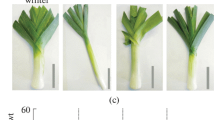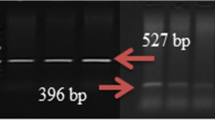Abstract
In four leek (Allium porrum L.) cultivars, VTC2 homologues cDNAs encoding GDP-L-galactose phosphorylase, a key enzyme of the L-galactose pathway of ascorbic acid (AsA) biosynthesis, were determined. VTC2 cDNA and encoded protein variability in the analyzed cultivars was evaluated. VTC2 expression patterns were defined in the roots, basal plate, pseudostem and leaves of each leek cultivar at three time points: during active growth (August), harvest (October), and after two months of storage (December). It was found that in the roots, VTC2 is expressed in a similar way in all studied cultivars, with the maximum level in October. After two months of storage, a decrease in VTC2 transcription level was observed in the analyzed leek tissues. The AsA content in the cultivars was determined, which positively correlated with the VTC2 expression level in green leaves (r = 0.34), while in white pseudostem, the correlation was negative (r = –0.58). In response to cold stress (+4°C), the VTC2 transcription level in green leaves changed only after 6 h of incubation. After 24 h, in green leaves, VTC2 expression levels and AsA contents were similar to the initial (0 hour) values both under normal conditions and in response to cold stress.



Similar content being viewed by others
REFERENCES
Gill, S.S. and Tuteja, N., Reactive oxygen species and antioxidant machinery in abiotic stress tolerance in crop plants, Plant Physiol. Biochem., 2010, vol. 48, p. 909.
Bilska, K., Wojciechowska, N., Alipour, S., and Kalemba, E.M., Ascorbic acid-the little-known antioxidant in woody plants, Antioxidants (Basel), 2019, vol. 8, art. ID 645. https://doi.org/10.3390/antiox8120645
Conklin, P.L. and Barth, C., Ascorbic acid, a familiar small molecule intertwined in the response of plants to ozone, pathogens, and the onset of senescence, Plant Cell Environ., 2004, vol. 27, p. 959.
Smirnoff, N., Ascorbic acid metabolism and functions: a comparison of plants and mammals, Free Radicals Biol. Med., 2018, vol. 22, p. 116. https://doi.org/10.1016/j.freeradbiomed.2018.03.033
Yang, X.Y., Xie, J.X., Wang, F.F., Zhong, J., Liu, Y.Z., Li, G.H., and Peng, S.A., Comparison of ascorbate metabolism in fruits of two citrus species with obvious difference in ascorbate content in pulp, J. Plant Physiol., 2011, vol. 168, p. 2196.
Broad, R.C., Bonneau, J.P., Hellens, R.P., and Johnson, A.A.T., Manipulation of ascorbate biosynthetic, recycling, and regulatory pathways for improved abiotic stress tolerance in plants, Int. J. Mol. Sci., 2020, vol. 21, art. ID 1790. https://doi.org/10.3390/ijms21051790
Giovannoni, J.J., Completing a pathway to plant vitamin C synthesis, Proc. Natl. Acad. Sci. U.S.A., 2007, vol. 104, p. 9109.
Ali, B., Pantha, S., Acharya, R., Ueda, Y., Wu, L.-B., Ashrafuzzaman, M., Ishizaki, T., Wissuwa, M., Bulley, S., and Frei, M., Enhanced ascorbate level improves multi-stress tolerance in a widely grown indica rice variety without compromising its agronomic characteristics, J. Plant Physiol., 2019, vol. 240, art. ID 152998. https://doi.org/10.1016/j.jplph.2019.152998
Dowdle, J., Ishikawa, T., Gatzek, S., Rolinski, S., and Smirnoff, N., Two genes in Arabidopsis thaliana encoding GDP-L-galactose phosphorylase are required for ascorbate biosynthesis and seedling, Plant J., 2007, vol. 52, p. 673.
Urzica, E.I., Adler, L.N., Page, M.D., Linster, C.L., Arbing, M.A., Casero, D., Pellegrini, M., Merchant, S.S., and Clarke, S.G., Impact of oxidative stress on ascorbate biosynthesis in Chlamydomonas via regulation of the VTC2 gene encoding a GDP-L-galactose phosphorylase, J. Biol. Chem., 2012, vol. 287, p. 14234. https://doi.org/10.1074/jbc.M112.341982
Bernaert, N., De Paepe, D., Bouten, C., De Clercq, H., Stewart, D., van Bockstaele, E., De Loose, M., and van Droogenbroeck, B., Antioxidant capacity, total phenolic and ascorbate content as a function of the genetic diversity of leek (Allium ampeloprasum var. porrum), Food Chem., 2012, vol. 134, p. 669. https://doi.org/10.1016/j.foodchem.2012.02.159
Liu, M., Wu, Z., and Jiang, F., Selection and validation of garlic reference genes for quantitative real-time PCR normalization, Plant Cell, Tissue Organ Cult., 2015, vol. 122, p. 435. https://doi.org/10.1007/s11240-015-0780-9
Schwinn, K.E., Ngo, H., Kenel, F., Brummell, D.A., Albert, N.W., McCallum, J.A., Pither-Joyce, M., Crowhurst, R.N., Eady, C., and Davies, K.M., The onion (Allium cepa L.) R2R3-MYB gene MYB1 regulates anthocyanin biosynthesis, Front. Plant. Sci., 2016, vol. 7, art. ID 1865. https://doi.org/10.3389/fpls.2016.01865
Brenner, C., Hint, Fhit, and GalT: function, structure, evolution, and mechanism of three branches of the histidine triad superfamily of nucleotide hydrolases and transferases, Biochemistry, 2002, vol. 41, no. 29, p. 9003.
Tyapkina, D.U., Kochieva, E.Z., and Slugina, M.A., Identification and analysis of VTC2 homologs encoding key enzyme of L-ascorbic acid biosynthesis in tomato species (Solanum section of Lycopersicon), Dokl. Biochem. Biophys., 2018, vol. 483, no. 1, p. 374. https://doi.org/10.1134/S1607672918060212
Huang, M., Xu, Q., and Deng, X.-X., L-ascorbic acid metabolism during fruit development in an ascorbate-rich fruit crop chestnut rose (Rosa roxburghii Tratt), J. Plant Physiol., 2014, vol. 171, p. 1205. https://doi.org/10.1016/j.jplph.2014.03.010
Dewhirst, R.A., Clarkson, G.J.J., Rothwell, S.D., and Fry, S.C., Novel insights into ascorbate retention and degradation during the washing and post-harvest storage of spinach and other salad leaves, Food Chem., 2017, vol. 233, p. 237. https://doi.org/10.1016/j.foodchem.2017.04.082
dos Santos, C.P., Batista, M.C., da Cruz Saraiva, K.D., Roque, A.L.M., de Souza Miranda, R., Alexandre e Silva, L.M., Moura, C.F.H., Alves Filho, E.G., Canuto, K.M., and Costa, J.H., Transcriptome analysis of acerola fruit ripening: insights into ascorbate, ethylene, respiration, and softening metabolisms, Plant Mol. Biol., 2019, vol. 101, p. 269. https://doi.org/10.1007/s11103-019-00903-0
Xiang, N., Hu, J., Wen, T., Brennan, M.A., Brennan, C.S., and Guo, X., Effects of temperature stress on the accumulation of ascorbic acid and folates in sweet corn (Zea mays L.) seedlings, J. Sci. Food Agric., 2020, vol. 100, p. 1694. https://doi.org/10.1002/jsfa.10184
Galani, J.H.Y., Mankad, P.M., Shah, A.K., Patel, N.J., Acharya, R.R., and Talati, J.G., Effect of storage temperature on vitamin C, total phenolics, UPLC phenolic acid profile and antioxidant capacity of eleven potato (Solanum tuberosum) varieties, Hortic. Plant J., 2017, vol. 3, p. 73. https://doi.org/10.1016/j.hpj.2017.07.004
Badejo, A.A., Fujikawa, Y., and Esaka, M., Gene expression of ascorbic acid biosynthesis related enzymes of the Smirnoff-Wheeler pathway in acerola (Malpighia glabra), J. Plant Physiol., 2009, vol. 166, p. 652. https://doi.org/10.1016/j.jplph.2008.09.004
Franceschi, V.R. and Tarlyn, N.M., L-ascorbic acid is accumulated in source leaf phloem and transported to sink tissues in plants, Plant Physiol., 2002, vol. 130, p. 649.
Gao, Q. and Zhang, L., Ultraviolet-B-induced oxidative stress and antioxidant defense system responses in ascorbate-deficient vtc1 mutants of Arabidopsis thaliana, J. Plant Physiol., 2008, vol. 165, p. 138.
Ioannidi, E., Kalamaki, M.S., Engineer, C., Pateraki, I., Alexandrou, D., Mellidou, I., Giovannonni, J., and Kanellis, A.K., Expression profiling of ascorbic acid-related genes during tomato fruit development and ripening and in response to stress conditions, J. Exp. Bot., 2009, vol. 60, p. 663. https://doi.org/10.1093/jxb/ern322
Li, J., Liang, D., Li, M., and Ma, F., Light and abiotic stresses regulate the expression of GDP-L-galactose phosphorylase and levels of ascorbic acid in two kiwifruit genotypes via light-responsive and stress-inducible cis-elements in their promoters, Planta, 2013, vol. 238, p. 535. https://doi.org/10.1007/s00425-013-1915-z
Fukunaga, K., Fujikawa, Y., and Esaka, M., Light regulation of ascorbic acid biosynthesis in rice via light responsive cis-elements in genes encoding ascorbic acid biosynthetic enzymes, Biosci., Biotechnol., Biochem., 2010, vol. 74, p. 888. https://doi.org/10.1271/bbb.90929
Liu, F., Xiang, N., Hu, J.G., Shijuan, Y., Xie, L., Brennan, C.S., Huang, W., and Guo, X., The manipulation of gene expression and the biosynthesis of vitamin C, E and folate in light-and dark-germination of sweet corn seeds, Sci. Rep., 2017, vol. 7, art. ID 7484. https://doi.org/10.1038/s41598-017-07774-9
Caverzan, A., Passaia, G., Rosa, S.B., Ribeiro, C.W., Lazzarotto, F., and Margis-Pinheiro, M., Plant responses to stresses: role of ascorbate peroxidase in the antioxidant protection, Genet. Mol. Biol., 2012, vol. 35, p. 1011. https://doi.org/10.1590/s1415-47572012000600016
Ferelli, A.M.C., Bolten, S., Szczesny, B., and Micallef, S.A., Salmonella enterica elicits and is restricted by nitric oxide and reactive oxygen species on tomato, Front. Microbiol., 2020, vol. 11, p. 391. https://doi.org/10.3389/fmicb.2020.00391
Sikora, M. and Świeca, M., Effect of ascorbic acid post-harvest treatment on enzymatic browning, phenolics and antioxidant capacity of stored mung bean sprouts, Food Chem., 2018, vol. 239, p. 1160. https://doi.org/10.1016/j.foodchem.2017.07.067
Funding
This study was financially supported by the Russian Foundation for Basic Research, project no. 19-016-00054 and partially supported by the President of Russian Federation grant no. MK-3350.2019.11 for determination of the VTC2 gene expression pattern in response to cold stress. The study was performed using the Experimental climate control facility at the Institute of Bioengineering, Research Centre of Biotechnology (Russia).
Author information
Authors and Affiliations
Corresponding author
Ethics declarations
Conflict of interests. The authors declare that they have no conflicts of interest.
Statement on the welfare of humans or animals. This article does not contain any studies involving animals performed by any of the authors.
Rights and permissions
About this article
Cite this article
Anisimova, O.K., Seredin, T.M., Shchennikova, A.V. et al. Estimation of the Vitamin C Content and GDP-L-Galactose Phosphorylase Gene (VTC2) Expression Level in Leek (Allium porrum L.) Cultivars. Russ J Plant Physiol 68, 85–93 (2021). https://doi.org/10.1134/S1021443720060023
Received:
Revised:
Accepted:
Published:
Issue Date:
DOI: https://doi.org/10.1134/S1021443720060023




